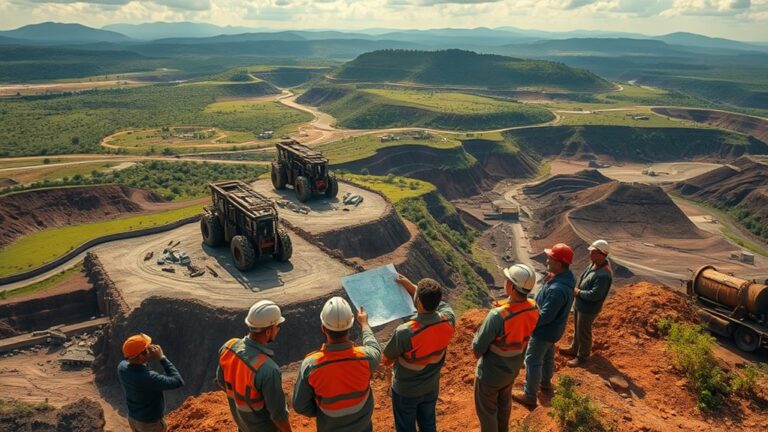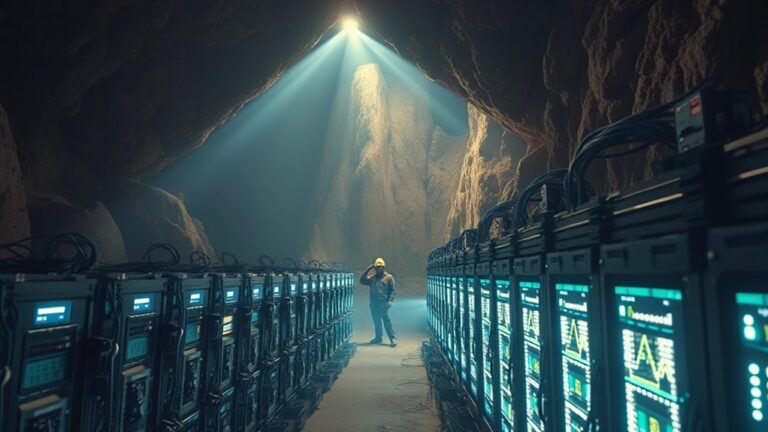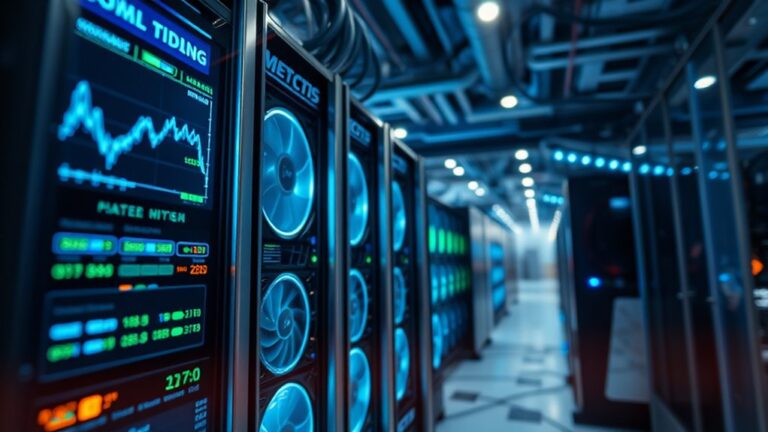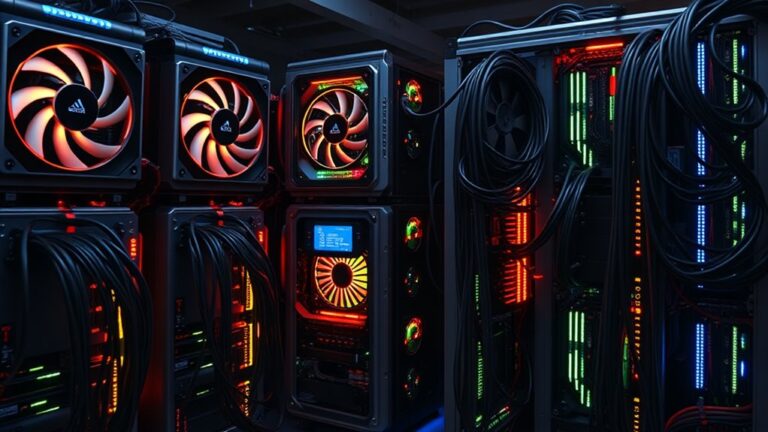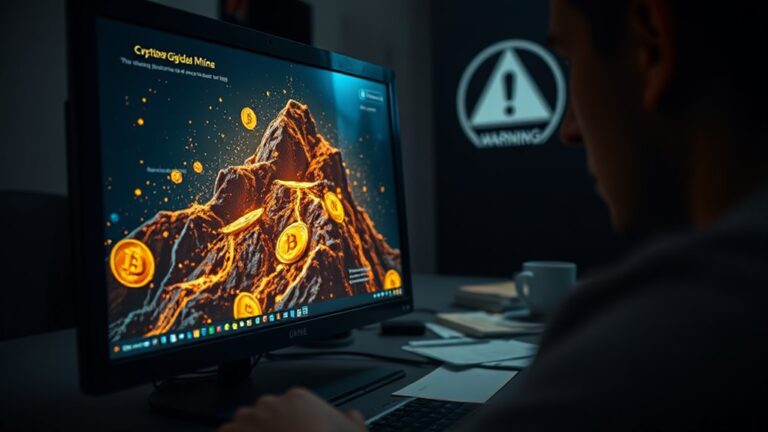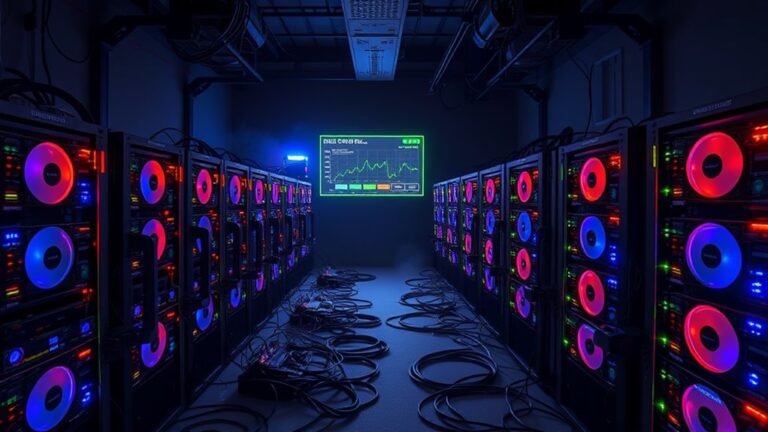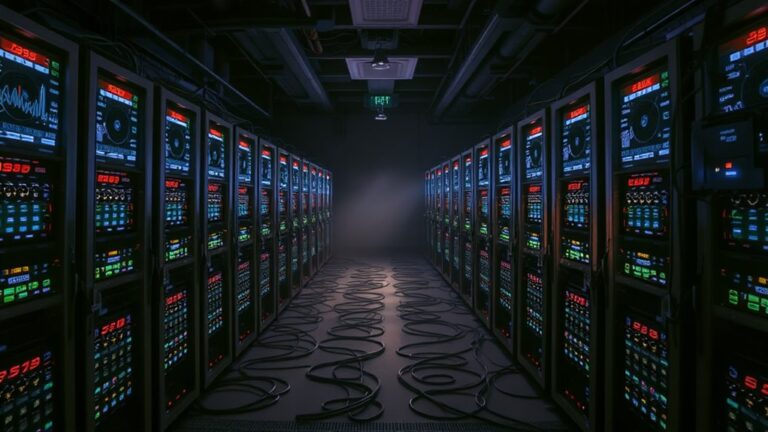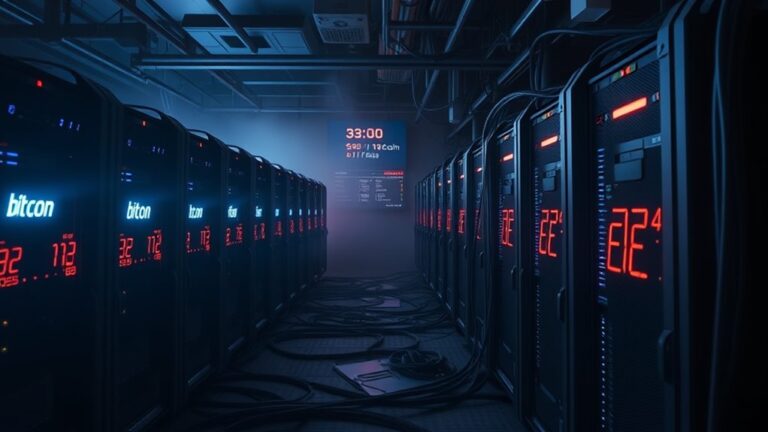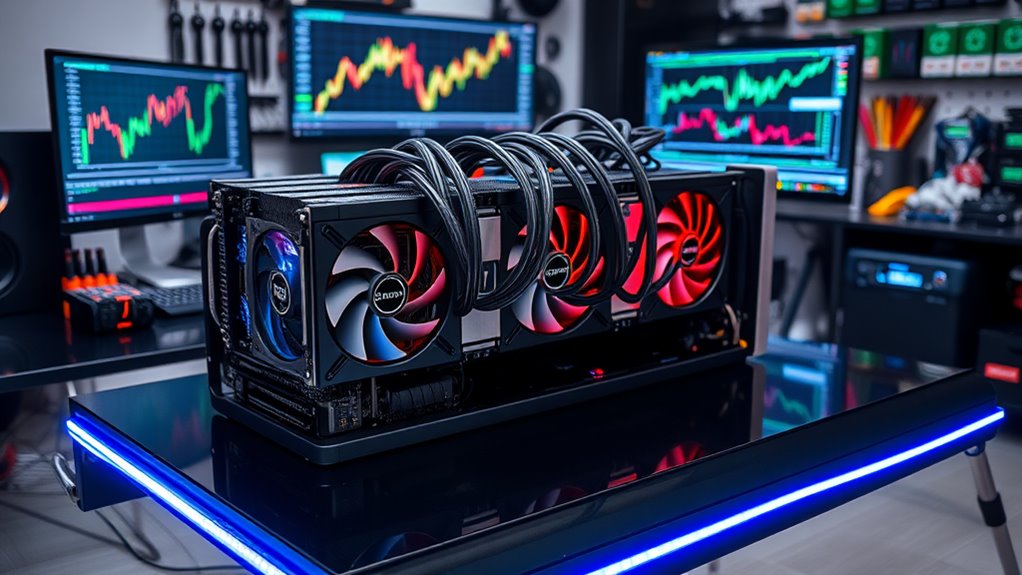
Setting Up a Mining Rig: A Step-by-Step Guide to Cryptocurrency Success
Setting up a mining rig involves several key steps. First, choose a cryptocurrency based on its mining algorithm and profitability. Next, gather compatible hardware, including a motherboard that supports multiple GPUs, and guarantee adequate power supply and cooling systems. Assemble the equipment, then install appropriate mining software. Joining a mining pool can enhance returns. Finally, monitor performance regularly and maintain compliance with legal regulations. Follow these steps to optimize your mining success. More insights are available on this topic.
Key Takeaways
- Choose compatible hardware, including a motherboard, GPUs, and a reliable PSU, to maximize mining efficiency and performance.
- Select appropriate mining software that suits your hardware and desired cryptocurrency for optimal configuration and management.
- Join a reputable mining pool to enhance your chances of consistent rewards while understanding fee structures and payout methods.
- Set up effective cooling systems and maintain proper airflow to prevent overheating and ensure the longevity of your mining rig.
- Monitor performance regularly, tracking metrics like hash rate and power consumption, and perform preventative maintenance to address issues promptly.
Cryptocurrency Selection
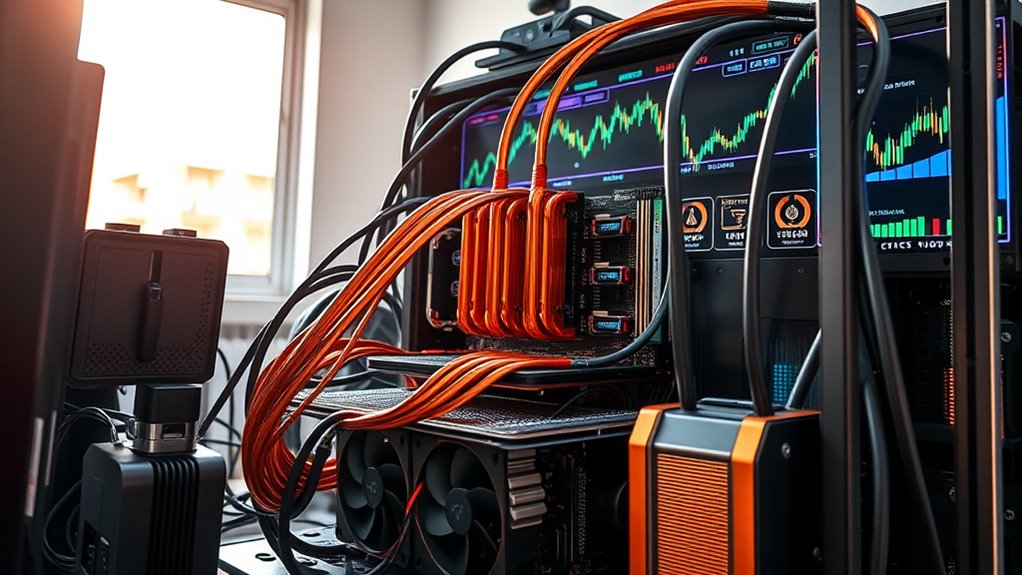
When selecting a cryptocurrency for mining, what factors should be considered to guarantee an informed decision?
First, an individual should assess the coin’s mining algorithm, as different algorithms require specific hardware. For instance, Bitcoin uses SHA-256 and demands ASIC miners, while Ethereum Classic employs Ethash, allowing for GPU mining.
Additionally, profitability hinges on cryptocurrency prices and blockchain difficulty; both can fluctuate considerably. Energy costs also play a vital role, as high expenses can diminish returns.
In addition, the competitive landscape of miners can affect individual profitability; thus, choosing less saturated coins like Monero or Ravencoin might be advantageous. Furthermore, understanding the different mining methods can help refine your strategy and ensure you choose the most suitable approach for your resources.
Hardware Requirements
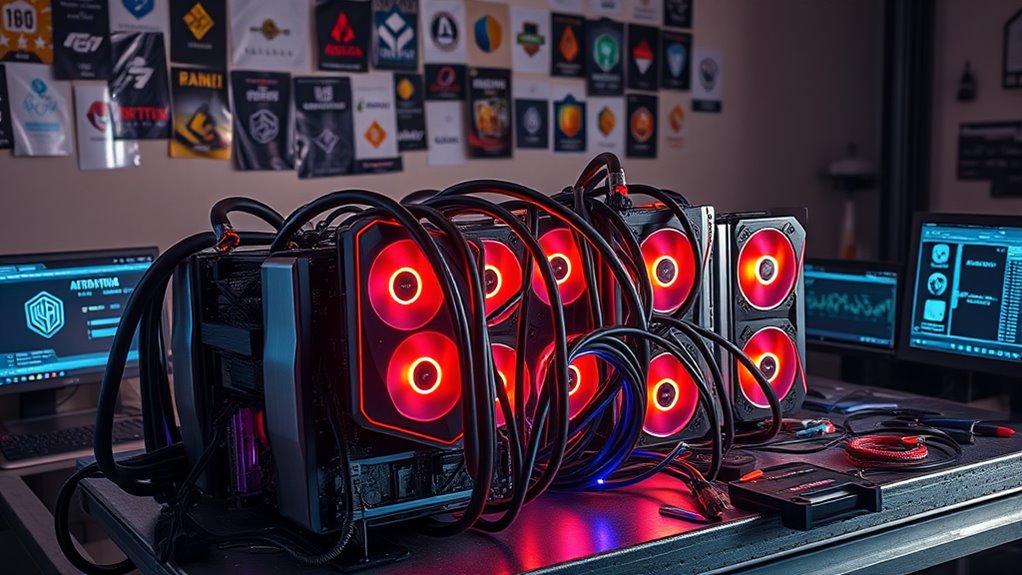
Setting up a mining rig requires careful consideration of various hardware components to guarantee peak performance and efficiency.
The motherboard is essential, as it influences compatibility with multiple GPUs, which are critical for mining due to their superior computational power. A basic CPU suffices for managing the rig’s operations. Adequate RAM and storage, such as SSDs or hard drives, ensure smooth functionality.
The power supply unit (PSU) must meet the energy demands of all components. Additionally, accessories like a cooling system are crucial to maintain low temperatures, while a mining frame supports the structure and airflow. Balancing power consumption and computational performance is essential for profitable mining.
Proper cabling and risers enhance connectivity and cooling efficiency, ensuring the rig operates effectively in a competitive mining environment.
Building the Mining Rig
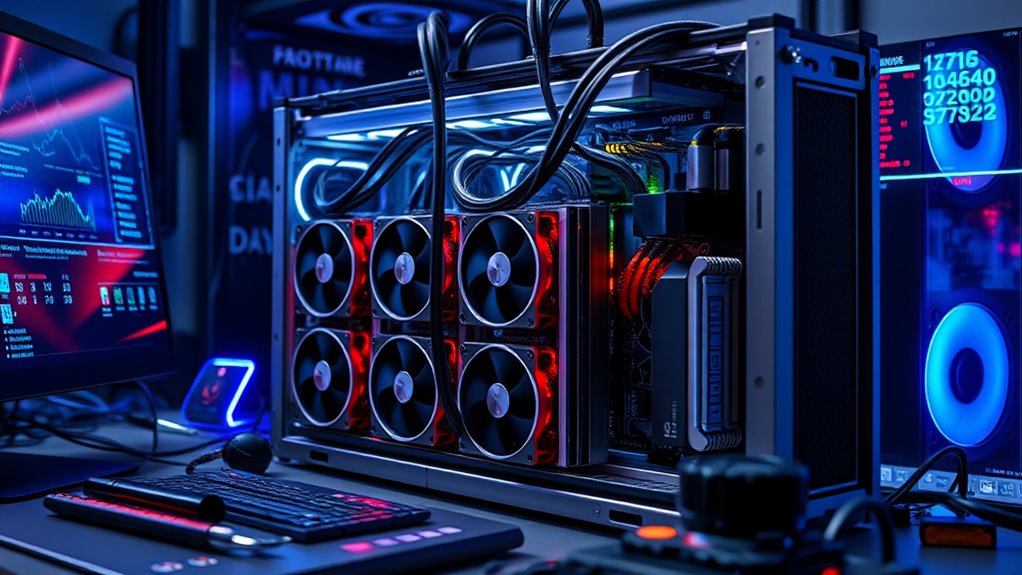
Building a mining rig involves a systematic approach to assembling various components to create an efficient and effective operation.
First, designing a layout is vital for ideal access, maintenance, and airflow to prevent overheating. Adequate space for future expansion should also be considered, along with compliance to local building codes.
Designing an efficient layout is crucial for optimal airflow, maintenance access, and future expansion while adhering to building codes.
Evaluating power requirements is essential; calculating total power consumption and consulting a certified electrician helps guarantee a safe power system.
Security measures must be implemented, including surveillance cameras and access control systems, to protect the facility.
Finally, setting up a reliable internet connection with wired Ethernet and redundancy will minimize downtime, enhancing overall mining performance. Additionally, choosing the right mining software options is crucial for maximizing profitability and optimizing your mining routine.
Each step contributes to a robust and sustainable mining operation.
Assembling Mining Equipment
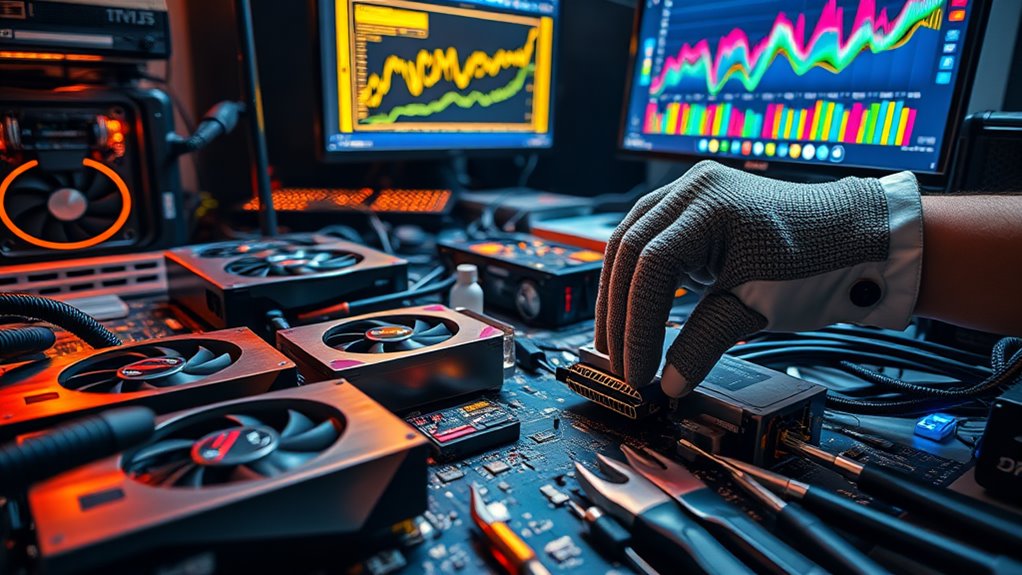
Assembling mining equipment requires careful selection and installation of components to guarantee peak performance.
First, individuals must choose hardware suited to their mining goals, taking into account factors such as efficiency, power consumption, and compatibility. Additionally, miners should consider incorporating renewable energy sources to enhance long-term profitability and reduce environmental impact.
Once the components are selected, a systematic installation process can begin, focusing on proper connections and configurations to create a functioning mining rig.
Component Selection Guidelines
When selecting components for a mining rig, careful consideration is important to guarantee peak performance and efficiency. The following guidelines can help ascertain that the chosen components meet the necessary requirements:
- GPUs: Select multiple high-performance GPUs, as they are essential for processing cryptographic equations efficiently.
- Motherboard: Choose a motherboard that supports multiple GPUs to maintain compatibility and stability throughout operations.
- Power Supply Unit (PSU): Invest in a high-capacity and reliable PSU, as it must provide sufficient power to all components while considering energy efficiency.
Additionally, consider the cooling system, as it is critical to prevent overheating, and confirm adequate airflow in the rig’s location for maximum performance. Choosing the right components can also impact your ability to mine profitable cryptocurrencies effectively, allowing you to adapt to market conditions and maximize your returns.
These choices will directly impact profitability and the rig’s overall effectiveness.
Installation Process Overview
The installation process of a mining rig is a methodical task that requires careful attention to detail and proper organization of components. First, the CPU is secured in its socket, followed by the RAM installation. The motherboard is then placed in the case, and cooling systems are added to prevent overheating. Next, the Power Supply Unit (PSU) is mounted, and power connections are established. Graphics cards are connected via PCIe risers, guaranteeing stability and airflow. Storage devices, preferably SSDs, are attached for efficiency, alongside necessary peripherals. Finally, all connections are verified, and the system is booted, leading to software installation and configuration. This meticulous setup is crucial for ensuring the mining rig can effectively engage in validating transactions, which is a vital function of crypto mining.
| Step | Action |
|---|---|
| Secure CPU | Install and lock into place |
| Connect PSU | Verify proper power distribution |
| Install GPUs | Securely attach for peak airflow |
Setting Up Mining Software
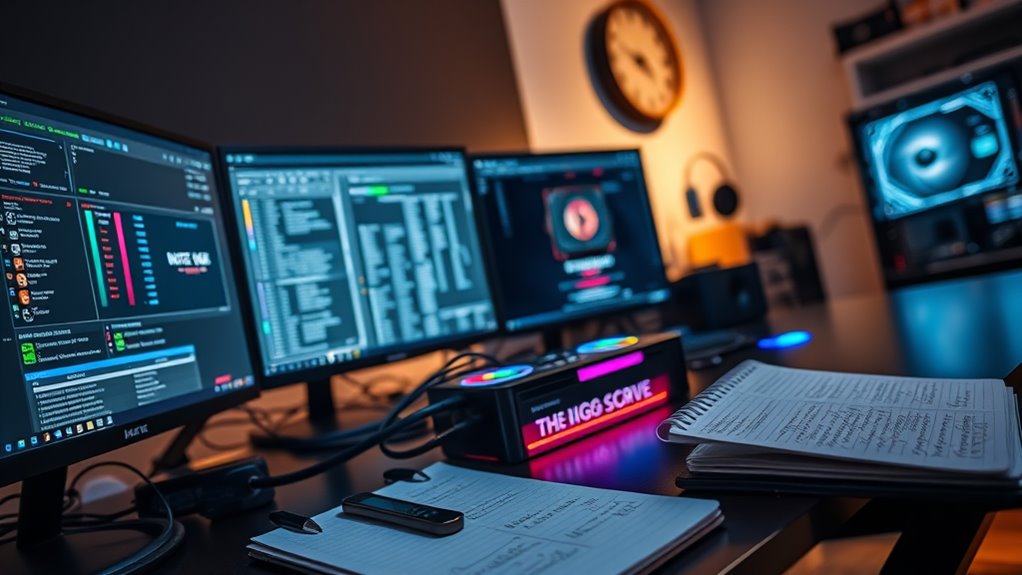
Setting up mining software is an essential step for anyone interested in cryptocurrency mining. Choosing the right software involves understanding its compatibility with your hardware and the specific requirements of the cryptocurrency you aim to mine.
Here are three key considerations:
- Software Types: Most mining software is free and compatible with various operating systems, including Windows, Linux, and macOS.
- Popular Options: CGMiner is widely used due to its command line interface and support for multiple algorithms, while alternatives like EasyMiner offer user-friendly interfaces.
- Configuration: Many software options allow customization of settings such as hash rates, fan speeds, and pool connections, enabling miners to optimize their performance effectively. Additionally, having the right mining software is crucial for successfully engaging in proof-of-work and ensuring the security of your mining operations.
Proper configuration and regular updates are vital for successful mining operations.
Joining a Mining Pool
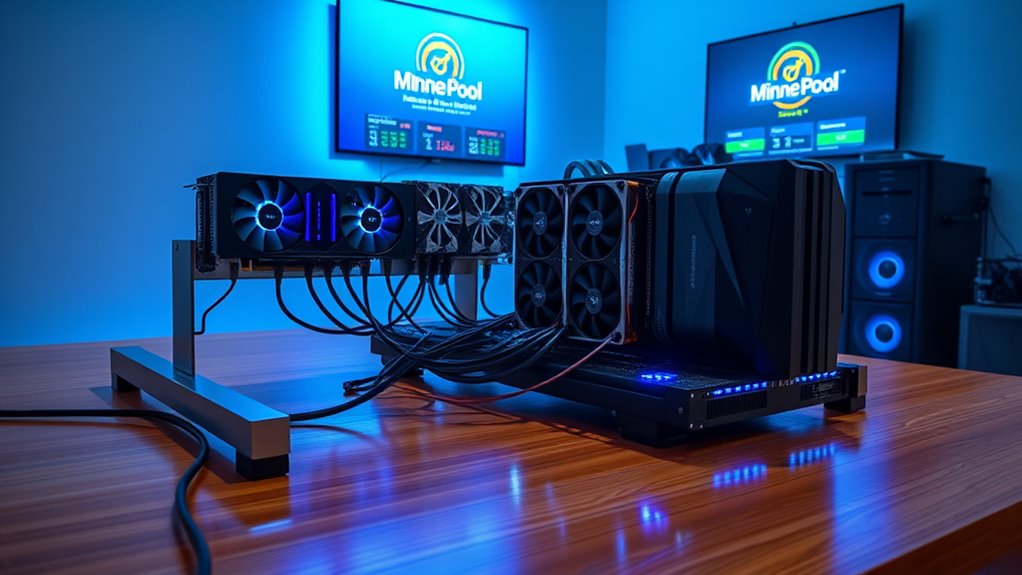
Joining a mining pool involves selecting the right pool that aligns with a miner’s goals and preferences.
Factors to take into account include the pool’s size, fee structure, and payout methods, as these can greatly affect overall earnings. Additionally, miners should consider the potential for consistent rewards, as this can impact their overall strategy and earnings stability. Once a suitable pool is chosen, configuring miner settings becomes essential to optimize performance and guarantee proper integration with the pool’s system.
Selecting the Right Pool
Selecting the right mining pool is an essential decision for anyone looking to maximize their mining profitability. A well-chosen pool can greatly enhance the chances of consistent rewards.
When evaluating a mining pool, consider the following criteria:
- Cryptocurrency Support: Confirm the pool supports the specific cryptocurrency you wish to mine.
- Fees and Payments: Understand the fee structures and payout methods, as these can affect your overall earnings.
- Reputation and Security: Research the pool’s reputation through user reviews, transparency, and history of security. Additionally, consider the importance of decentralization in pool selection, as it can impact both security and performance.
Configuring Miner Settings
Configuring miner settings to join a mining pool involves several important steps that guarantee effective participation and ideal performance.
First, miners should select suitable software options, such as CGMiner or EasyMiner, to connect to the chosen pool. Next, they must enter the mining pool’s server address, port number, and their username to establish a connection.
Additionally, providing a cryptocurrency wallet address is essential for receiving rewards. Miners should also be aware of any pool limitations, such as minimum hash rates.
After entering all necessary information, restarting the mining software is vital to apply the new settings. Understanding the pool’s reward mechanisms, such as PPS or PPLNS, further enhances the mining experience and potential profitability.
Monitoring and Maintenance
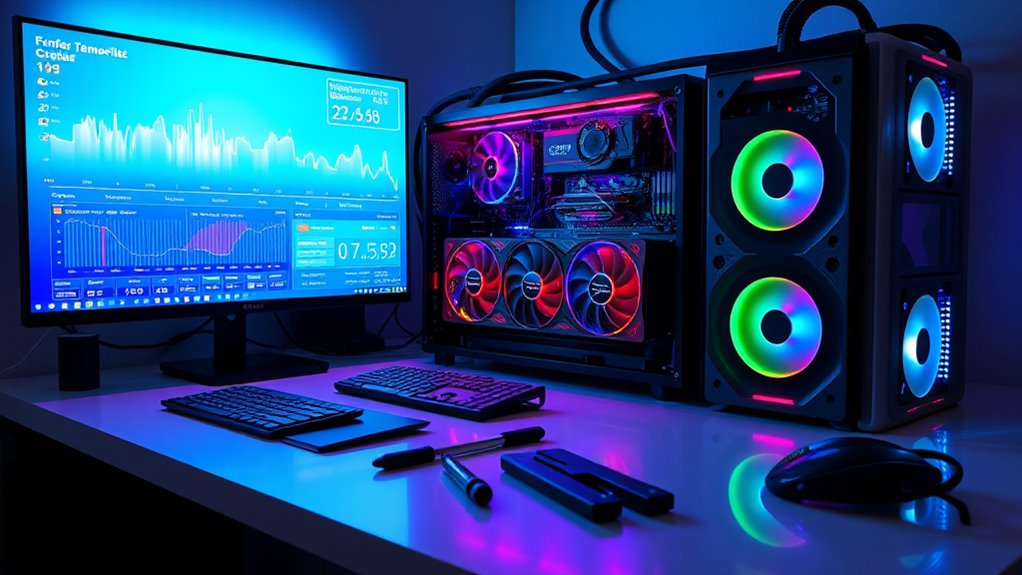
Monitoring and maintaining a mining rig is essential for ensuring ideal performance and longevity. Proper oversight helps prevent issues that could hinder mining efficiency.
Effective monitoring and maintenance of a mining rig is crucial for optimal performance and long-term reliability.
To achieve this, miners should focus on key areas:
- Performance Tracking: Regularly monitor hash rate, temperature, and power consumption to optimize efficiency.
- Preventative Maintenance: Clean dust from components and check cooling systems to prevent overheating, ensuring smooth operation.
- Troubleshooting: Address common issues like power outages and network connectivity to maintain continuous mining. Additionally, understanding the impact of halvings on profitability can help miners strategize their operations effectively after significant market events.
Legal Compliance
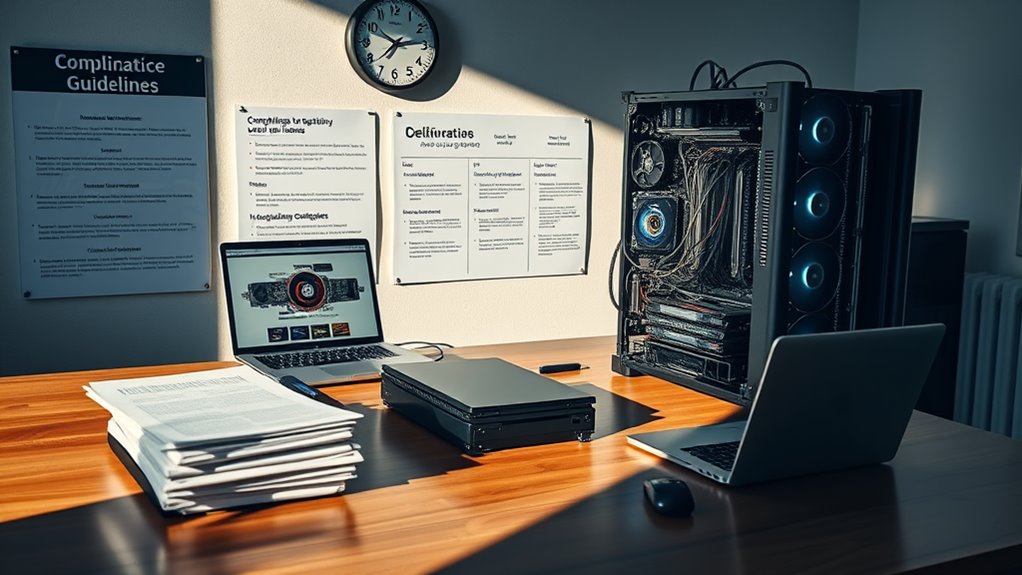
Legal compliance is a significant aspect of operating a mining rig, as it involves adhering to various regulations that can vary widely depending on location.
Cryptocurrency mining income is often taxed as self-employment, particularly in the U.S. and Canada, necessitating accurate record-keeping. Large-scale operations may require specific licenses and compliance with zoning laws.
Additionally, miners must navigate import/export laws for equipment and adhere to Anti-Money Laundering (AML) and Know Your Customer (KYC) regulations in certain jurisdictions.
Environmental regulations may also restrict energy usage, pushing miners toward renewable sources. Given the evolving legal landscape, seeking guidance from a cryptocurrency attorney and staying informed about local laws is essential for successful and compliant mining operations.
Market Analysis
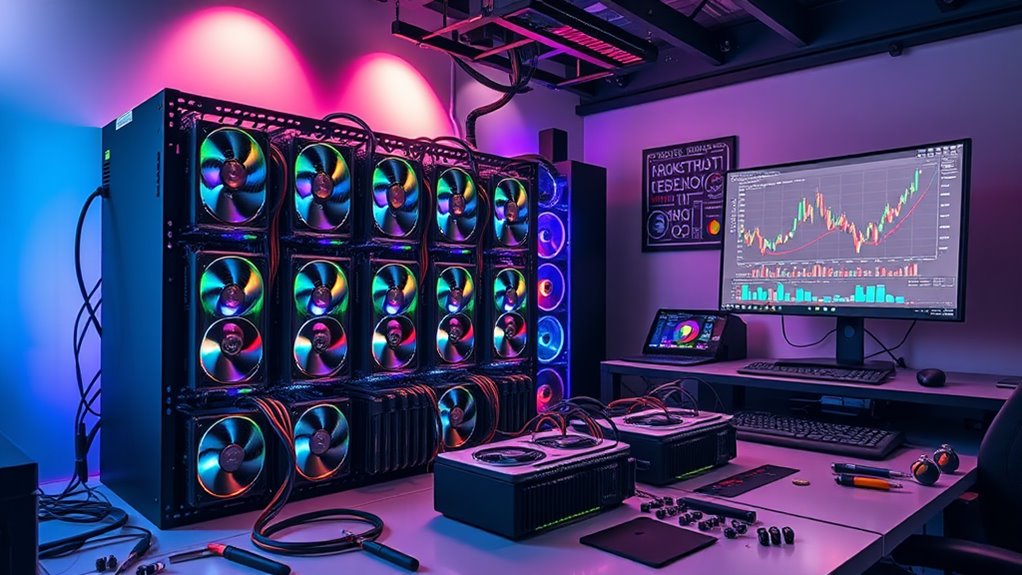
As the cryptocurrency landscape continues to evolve, a thorough market analysis is essential for anyone considering entering the mining sector. Understanding current trends can guide decisions and optimize investments.
Key factors influencing the market include:
- Adoption Rates: By 2025, 28% of American adults are expected to own cryptocurrencies, indicating growing acceptance.
- Market Projections: Bitcoin could range from $85,500 to $185,000, reflecting bullish sentiments.
- Regional Variations: Europe leads in adoption, while North America and Asia Pacific also show significant growth potential.
These elements reveal a dynamic market driven by technological advancements and regulatory changes, making informed analysis pivotal for potential miners.
Keeping abreast of these trends can enhance strategic planning in cryptocurrency investments.
Frequently Asked Questions
How Long Does It Take to Set up a Mining Rig?
The time required to set up a mining rig varies markedly, typically ranging from several hours to a few days. Factors influencing this duration include component selection, physical assembly, software installation, and testing processes.
What Are the Ongoing Costs of Mining Cryptocurrencies?
Ongoing costs of cryptocurrency mining include electricity, hardware maintenance, and cooling systems. Additionally, miners face expenses related to upgrades, energy efficiency measures, and potential equipment failures, all of which greatly affect overall profitability.
Can I Mine Cryptocurrency on a Laptop?
In the digital landscape, a laptop stands as a fragile sailboat amidst treacherous seas. While it can mine cryptocurrency, the journey is fraught with inefficiency, overheating risks, and low profitability compared to dedicated mining setups.
Is Mining Profitable in 2023?
In 2023, mining profitability varies considerably, influenced by market volatility, energy costs, hardware efficiency, and regulatory changes. Miners must adapt to maintain profitability, considering factors like location and investment in technology.
What Happens if My Mining Rig Fails?
“When it rains, it pours.” If a mining rig fails, downtime ensues, leading to diminished efficiency and profitability. Regular maintenance can prevent such failures, ensuring peak performance and safeguarding investments from costly disruptions.
Conclusion
In summary, setting up a mining rig can be a rewarding venture for those interested in cryptocurrency. With over 100 million active cryptocurrency users worldwide, the potential for profit remains significant. By carefully selecting the right hardware, software, and mining pool, individuals can enhance their chances of success. Regular monitoring and maintenance are essential for peak performance. Additionally, understanding legal compliance and market dynamics can further empower miners to navigate this evolving landscape effectively.

